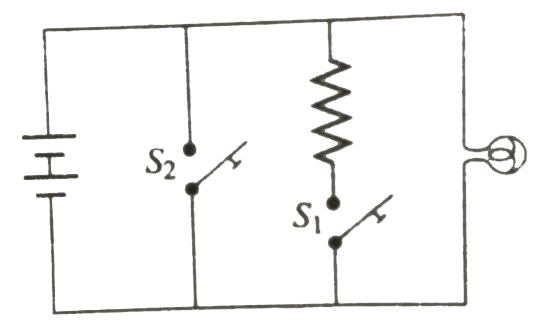An electrical system has open-closed switches S1,S2 and S3 as shown in fig. The switches operate independently of one another and the current will flow from A→B either if S1 is closed or if both S2 and S3 are closed. If P(S1)=P(S2)=P(S3)=1/2, then find the probability that the circuit will work.
To solve the problem, we need to find the probability that the circuit will work given the conditions of the switches. Let's break down the solution step by step.
Step 1: Define the Events
Let:
- E be the event that the circuit works.
- S1 be the event that switch S1 is closed.
- S2 be the event that switch S2 is closed.
- S3 be the event that switch S3 is closed.
The circuit will work if either:
1. S1 is closed, or
2. Both S2 and S3 are closed.
Step 2: Express the Probability
The probability that the circuit works can be expressed as:
P(E)=P(S1)+P(S2∩S3)−P(S1∩S2∩S3)
Step 3: Calculate Individual Probabilities
Given that:
P(S1)=P(S2)=P(S3)=12
Since the switches operate independently, we can calculate P(S2∩S3) as:
P(S2∩S3)=P(S2)⋅P(S3)=12⋅12=14
Step 4: Calculate the Intersection Probability
Now, we need to calculate P(S1∩S2∩S3):
P(S1∩S2∩S3)=P(S1)⋅P(S2)⋅P(S3)=12⋅12⋅12=18
Step 5: Substitute Values into the Probability Formula
Now we can substitute these probabilities into the equation for P(E):
P(E)=P(S1)+P(S2∩S3)−P(S1∩S2∩S3)
P(E)=12+14−18
Step 6: Find a Common Denominator and Calculate
To add these fractions, we find a common denominator, which is 8:
P(E)=48+28−18=4+2−18=58
Final Answer
Thus, the probability that the circuit will work is:
58
Let:
- E be the event that the circuit works.
- S1 be the event that switch S1 is closed.
- S2 be the event that switch S2 is closed.
- S3 be the event that switch S3 is closed.
1. S1 is closed, or
2. Both S2 and S3 are closed.
The probability that the circuit works can be expressed as:
P(E)=P(S1)+P(S2∩S3)−P(S1∩S2∩S3)
Given that:
P(S1)=P(S2)=P(S3)=12
P(S2∩S3)=P(S2)⋅P(S3)=12⋅12=14
Now, we need to calculate P(S1∩S2∩S3):
P(S1∩S2∩S3)=P(S1)⋅P(S2)⋅P(S3)=12⋅12⋅12=18
Now we can substitute these probabilities into the equation for P(E):
P(E)=P(S1)+P(S2∩S3)−P(S1∩S2∩S3)
P(E)=12+14−18
To add these fractions, we find a common denominator, which is 8:
P(E)=48+28−18=4+2−18=58
Thus, the probability that the circuit will work is:
58
Similar Questions
An electrical system has open-closed switches S1,S2andS3 as shown in fig. The switches operate independently of one another and the current will flow from A→B either if S1 is closed or if both S2andS3 are closed. If P(S1)=P(S2)=P(S3)=1/2, then find the probability that the circuit will work. fig
View SolutionAn electrical system has open-closed switches S1,S2andS3 as shown in fig. The switches operate independently of one another and the current will flow from A→B either if S1 is closed or if both S2andS3 are closed. If P(S1)=P(S2)=P(S3)=1/2, then find the probability that the circuit will work. fig
View SolutionWhich of two switches S1andS2 shown in Fig. 7.31 will produce short - circuiting?

View SolutionIn fig. A2.27, the charge that flows from P to Q when the switch S is closed is

View SolutionThe flow of charge through switch S if it is closed is

View SolutionConsider the situation shown in figure. The switch S is open for a long time and then closed.

Find the charge flown through the battery when the switch S is closed.
View SolutionConsider the situation shown in figure . If the switch is closed and after some time it is opened again , the closed loop will show

View SolutionWhen the switch S, in the circuit shown, is closed, then the value of current I will be :

View SolutionConsider the situation shown in figure (31-E23 ) . The switch S is open for a long time and then closed . (a) Find the charge flown through the battery when the switch S is closed (b)Find the work done by the battery .

View SolutionIn the circuit shown in figure, reading of voltmeter is V1 when only S1 is closed, reading of voltmeter is V2 when only S2 is closed, and reading of voltmeter is V3 when both S1andS2 are closed. Then .

View Solution
